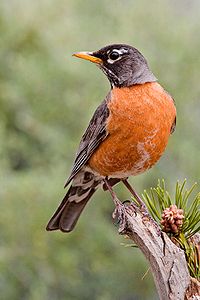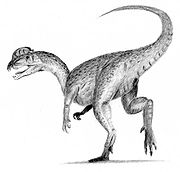
Fauna of Connecticut
Encyclopedia

Fauna
Fauna or faunæ is all of the animal life of any particular region or time. The corresponding term for plants is flora.Zoologists and paleontologists use fauna to refer to a typical collection of animals found in a specific time or place, e.g. the "Sonoran Desert fauna" or the "Burgess shale fauna"...
of Connecticut
Connecticut
Connecticut is a state in the New England region of the northeastern United States. It is bordered by Rhode Island to the east, Massachusetts to the north, and the state of New York to the west and the south .Connecticut is named for the Connecticut River, the major U.S. river that approximately...
comprise a variety of animal
Animal
Animals are a major group of multicellular, eukaryotic organisms of the kingdom Animalia or Metazoa. Their body plan eventually becomes fixed as they develop, although some undergo a process of metamorphosis later on in their life. Most animals are motile, meaning they can move spontaneously and...
species
Species
In biology, a species is one of the basic units of biological classification and a taxonomic rank. A species is often defined as a group of organisms capable of interbreeding and producing fertile offspring. While in many cases this definition is adequate, more precise or differing measures are...
.
- The state bird is the American RobinAmerican RobinThe American Robin or North American Robin is a migratory songbird of the thrush family. It is named after the European Robin because of its reddish-orange breast, though the two species are not closely related, with the European robin belonging to the flycatcher family...
. - The state insect is the European MantisEuropean mantisMantis religiosa, referred to as the European Mantis outside of Europe and known simply as the Praying Mantis in Europe and elsewhere, is one of the most well-known and widespread species of the order Mantodea.-Overview:...
. - The state animal is the Sperm WhaleSperm WhaleThe sperm whale, Physeter macrocephalus, is a marine mammal species, order Cetacea, a toothed whale having the largest brain of any animal. The name comes from the milky-white waxy substance, spermaceti, found in the animal's head. The sperm whale is the only living member of genus Physeter...
. - The state shellfish is the Eastern OysterEastern oysterThe eastern oyster — also called Atlantic oyster or Virginia oyster — is a species of true oyster native to the eastern seaboard and Gulf of Mexico coast of North America. It is also farmed in Puget Sound, Washington, where it is known as the Totten Inlet Virginica. Eastern oysters are and have...
. - The state fish is the American ShadAmerican shad-Introduction:The American shad or Atlantic shad, Alosa sapidissima, is a species of anadromous fish in family Clupeidae of order Clupeiformes. It is not closely related to the other North American shads...
. - The state fossilState fossilMost American states have made a state fossil designation, in many cases during the 1980s. It is common to designate one species in which fossilization has occurred, rather than a single specimen, or a category of fossils not limited to a single species....
is the Eubrontes giganteusEubrontesEubrontes is the name of fossilised dinosaur footprints dating from the Late Triassic and Early Jurassic. They have been identified from France, Poland, Slovakia, Italy, Spain, Australia and the USA...
.
Biodiversity
There are, as of 2004, 256 Connecticut species listed as endangered, threatened or of special concern. These are 11 species of mammalMammal
Mammals are members of a class of air-breathing vertebrate animals characterised by the possession of endothermy, hair, three middle ear bones, and mammary glands functional in mothers with young...
s, 50 species of bird
Bird
Birds are feathered, winged, bipedal, endothermic , egg-laying, vertebrate animals. Around 10,000 living species and 188 families makes them the most speciose class of tetrapod vertebrates. They inhabit ecosystems across the globe, from the Arctic to the Antarctic. Extant birds range in size from...
s, 11 species of reptile
Reptile
Reptiles are members of a class of air-breathing, ectothermic vertebrates which are characterized by laying shelled eggs , and having skin covered in scales and/or scutes. They are tetrapods, either having four limbs or being descended from four-limbed ancestors...
s, 7 species of amphibian
Amphibian
Amphibians , are a class of vertebrate animals including animals such as toads, frogs, caecilians, and salamanders. They are characterized as non-amniote ectothermic tetrapods...
s, 7 species of fish
Fish
Fish are a paraphyletic group of organisms that consist of all gill-bearing aquatic vertebrate animals that lack limbs with digits. Included in this definition are the living hagfish, lampreys, and cartilaginous and bony fish, as well as various extinct related groups...
, and 170 species of invertebrate
Invertebrate
An invertebrate is an animal without a backbone. The group includes 97% of all animal species – all animals except those in the chordate subphylum Vertebrata .Invertebrates form a paraphyletic group...
s.
Ancient life

Extinct species that once roamed Connecticut include Coelophysis
Coelophysis
Coelophysis , meaning "hollow form" in reference to its hollow bones , is one of the earliest known genera of dinosaur...
, Dilophosaurus
Dilophosaurus
Dilophosaurus was a theropod dinosaur from the Sinemurian stage of the Early Jurassic Period, about 193 million years ago. The first specimens were described in 1954, but it was not until over a decade later that the genus received its current name...
, and Eubrontes
Eubrontes
Eubrontes is the name of fossilised dinosaur footprints dating from the Late Triassic and Early Jurassic. They have been identified from France, Poland, Slovakia, Italy, Spain, Australia and the USA...
.
AnnelidAnnelidThe annelids , formally called Annelida , are a large phylum of segmented worms, with over 17,000 modern species including ragworms, earthworms and leeches...
s
- Ampharete arctica
- Capitella capitataCapitella capitataThe Capitella capitata is a polychaete worm that grows up to 10 cm in length. It is often blood-red in colour. The species is sedentary and fragile, with a flexible body....
- Capitellidae
- Eteone lactea
- Glycera dibranchiata
- Alitta (Nereis) succineaAlitta succineaAlitta succinea is a species of marine annelid in the Nereididae family...
- Ophelia sp.
- Phyllodoce sp.
- Polydora sp.
- Scoloplos robustus
- Spio setosa
- SpionidaeSpionidaeSpionidae is a family within the Polychaeta. Spionids are selective deposit feeders that use their two grooved palps to locate prey but some spionids are capable of interface feeding i.e. switching between deposit and suspension feeding. Spionids produce tubes by cementing sand grains and detritus...
- Streblospio benedicti
- Syllidae sp.
ArthropodArthropodAn arthropod is an invertebrate animal having an exoskeleton , a segmented body, and jointed appendages. Arthropods are members of the phylum Arthropoda , and include the insects, arachnids, crustaceans, and others...
s
- Chiridotea s p p.
- Gammarus sp.
- Neomysis americana
- Sphaeroma quadridentata
Mollusks
- Acteocina canaliculata
- Gemma gemma
- Nassarius obsoletusNassarius obsoletusThe eastern mudsnail, Ilyanassa obsoleta, is a species of sea snail, a marine gastropod mollusk in the family Nassariidae, the nassa mud snails.-Shell description:...
- Mulinia lateralis
- Mya arenaria
- Nucula sp.
- Periploma papyratium
- Retusa canaliculata
- Tellina agillis
Further reading
- Aspects of Connecticut's Physical Geography
- Connecticut Audubon Society
- Connecticut Department of Environmental Protection - Natural Diversity Data Base
- Fishes of the Connecticut River
- The Flora and Fauna of Branford
See also
- Flora of ConnecticutFlora of ConnecticutThe flora of Connecticut comprise a variety of plant species. Geobotanically, Connecticut belongs to the North American Atlantic Region.* The state tree is the White Oak; or more specifically, the Charter Oak.* The state flower is the Mountain Laurel....
- List of Connecticut birds
- List of mammals in Connecticut
- Mammals of New EnglandMammals of New EnglandThere are 7 orders, 17 families, 40 genera, and 60 species represented among the Mammals of New England. If extirpated, coastal, introduced, and accidental species are included these numbers increase to 8 orders, 26 families, 67 genera, and 105 species. The region includes the U.S...

